How a dishwasher works (basic principles)
 Dishwashers are rather poorly distributed in the CIS countries. According to statistics, only about 5% of families use dishwashers, even though the prices for such equipment are currently acceptable.
Dishwashers are rather poorly distributed in the CIS countries. According to statistics, only about 5% of families use dishwashers, even though the prices for such equipment are currently acceptable.
The main reason for this is people's doubts about the quality of the work of these household appliances, they say, they will not be able to wash the dishes better than we would do it by hand. Considering the principle of operation of the dishwasher, we will try to dispel this myth and convince you that the "dishwasher" is a very useful device.
Description of the processes in the dishwasher
Despite people's prejudice that the dishwasher is a very complex and moody appliance, let’s say that this is completely wrong. "Dishwasher" refers to technically simple units, and to understand the principles of its operation is not difficult. As soon as we put the dishwasher in place, connect it to the water supply, sewer and mains, and then load the dirty dishes, a number of interesting processes take place.
- First, we set the washing program, press the start button, and then leave to go about our business.
- Without us, the washing cycle begins, which is carried out without human intervention. The control unit gives a command, the intake valve opens and water flows into a special container.
- Next is the mixing of water with salt. Salt softens water and makes washing dishes more efficient. At the same time, the control module activates the heating element. Further processes do not start until the water in the chamber is heated to the desired temperature (the temperature is set by the user).
Note! Some models of dishwashers are connected simultaneously to hot and cold water. In this case, the system mixes the water, and the temperature sensor determines whether its temperature matches the program.
- Further actions of the dishwasher depend on the program set. Suppose
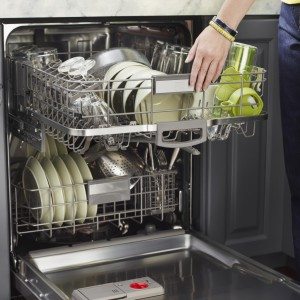 the utensils we loaded were very dirty, and we first turned on the soaking mode. The control module instructs the circulation pump to deliver the mixture of water and detergent in very small portions to the sprayer, which begins to spray the dirty dishes with drops for a long time, to ensure the effect of deoxidation of dried dirt.
the utensils we loaded were very dirty, and we first turned on the soaking mode. The control module instructs the circulation pump to deliver the mixture of water and detergent in very small portions to the sprayer, which begins to spray the dirty dishes with drops for a long time, to ensure the effect of deoxidation of dried dirt. - Next, the primary rinse is activated. Now the circulation pump feeds the mixture into the sprayer, and the remaining food is washed off under pressure. The main sprinkler is located at the bottom of the hopper under the lower basket for dishes. It not only sprays water and detergents, but also rotates, which makes it possible to cover all dishes.
- Subsequently, the water that was used for rinsing does not drain, but passes through the coarse filters and returns to the tank. There, the system increases the concentration of the detergent and the dishes are again sprayed, which allows you to remove most of the contaminants from it.
Important! Rinsing with detergents can be repeated several times, depending on the installed program, this extends the washing time.
- Then the system gives a command to drain the waste water. Dirty water is pumped out by a drain pump, in return a little water is poured, which rinses the tank from the inside, and then it is drained into the sewer.
- Now the valve opens and clean water is poured into the tank to rinse the dishes from
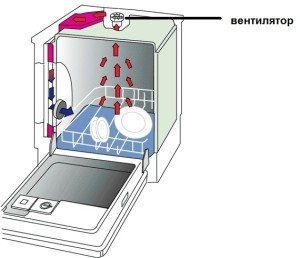 residues of dirt and detergent. The algorithm is simple, clean water under considerable pressure is supplied by a circulation pump to the sprayer, and it sprays the remnants of detergent from the dishes. The device can repeat the process of rinsing the dishes, which increases the execution time of the program.
residues of dirt and detergent. The algorithm is simple, clean water under considerable pressure is supplied by a circulation pump to the sprayer, and it sprays the remnants of detergent from the dishes. The device can repeat the process of rinsing the dishes, which increases the execution time of the program. - Next, the control module gives a command to drain the waste water, and the pump removes water from the tank into the sewer.
- Now it's time to dry. If the dishwasher has a forced drying function, a special fan pumps hot air, which is heated by the heater, into the hopper with dishes, and it dries very quickly. If there is no such function, then drying is carried out naturally in convection mode.
We have described, in general terms, what happens inside the dishwasher. Perhaps our description will seem complicated to you, then you can watch a video that demonstrates the operation of the dishwasher. Or you can find and watch the video and compare it with our description. As you wish, just to get an idea about the operation of dishwashers, you will spend a little time on this.
How is the dishwasher arranged?
To better understand what happens inside the dishwasher during operation, you need to study its structure. If we disassemble the dishwasher and look at its device from the inside, then we will see a system of units and sensors interacting with each other. Although the machine is arranged and it is not difficult, if you are going to disassemble it for the first time in your life, record your actions on video. The video will then help to correctly put all the parts in place after the repair work.
The main parts of the dishwasher are located in the lower part of the case, from the inside it looks quite interesting. In the bowels of the body is located:
- Tray in which to place dirty dishes.
- The closer allowing to smoothly open and close a door.
- Spray bar (there may be two or even three).
- A sensor that measures the temperature of water.
- Mesh filter and filter for rough water purification.
- Hose for draining waste water into the sewer.
- Pressure limiting valve.
- Pump draining waste water.
- Water tank.
- An element of the leakage protection system.
- Control module.
- The main pump (circulating).
- Condensing element.
- Rinse aid container.
- Blocking element.
- Capacity for detergents.
- Filling valve.
- Rubber seal located on the edge of the door.
- Salt compartment.
- Instantaneous water heating element.
- Inlet hose.
- Guides for dish trays.
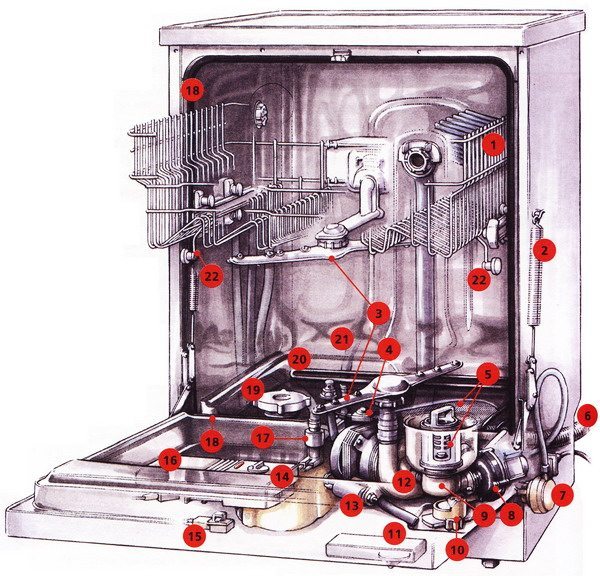
Here is a general list of items installed in the dishwasher. Where and how they are installed, you can see in the picture above. If this is not enough to understand the big picture, you can find a video on the Internet where the details of the dishwasher are demonstrated.
Why does a “dishwasher” wash even very dirty dishes?
Now dispel the myth of the inefficiency of the dishwasher. Numerous tests, both in laboratory conditions and in the conditions of an ordinary average apartment, confirm that the “dishwasher” copes with the care of a whole mountain of dishes. Why is she doing this? There are at least three good reasons:
- washing dishes using a solution of special salt and detergents that dissolve food debris and fat;
- washing occurs in water heated to the optimum temperature;
- the dishes are sprayed with water, which is fed fan-shaped under high pressure, which makes it possible to spray all laundered items from all sides.
Of course, if you put a pan with a centimeter layer of burning in the dish tray, the dishwasher is unlikely to cope with such pollution. However, it is reliably known that after a washing cycle, even such dirt is greatly softened from the inside and it can, then be removed manually, using a small amount of abrasive detergent. In general, without exaggeration, we can say that the dishwasher is one of the most necessary household appliances in the kitchen, and if this story did not convince you, read Bosch dishwasher reviews, perhaps the opinion of consumers will be more significant for you.
Note! Young mothers appreciate dishwashers not even for washing dishes, but for caring for children's toys. On the video on the Internet you can see how mothers clog the trays of the “dishwasher” with toys, and at the output they get everything clean.
In conclusion, we note, if you do not go into technical details, the principle of operation of the dishwasher is very simple. However, an understanding of this principle is important for the user, both during the daily operation of the "home assistant", and in the event that later it needs to be repaired. Thank you for your attention and good luck!
Interesting:
2 reader comments
Add a comment Cancel reply
Headings
Washing machine repair


For buyers
For users

Dishwasher

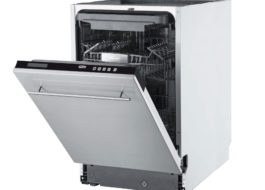

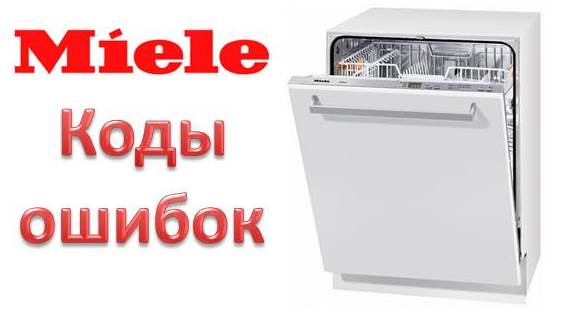

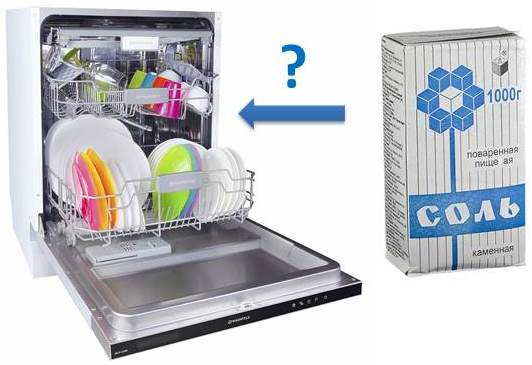












Since when has salt been used to wash dishes? It is used to clean the membrane of the ion filter of a water softener.
There is not an ion filter, but a softener, which with the help of an ion exchange resin replaces hardness salts (potassium and magnesium) with sodium salts.